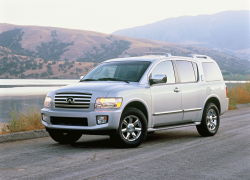— A $25 million lawsuit blames Nissan brake problems on a deadly crash involving a 2004 Infiniti QX56 and the deaths of a mother and her two children.
The lawsuit says the 2004 QX56 that was involved in the crash had been purchased by 74-year-old Solomon Mathenge in August 2012. Although previous owners hadn't complained about brake problems, the SUV needed repairs caused by previous crashes.
Mathenge had it towed to a body shop that repaired the damage and serviced the car, receiving a certificate the vehicle had been inspected and was in working condition. However, no software updates were performed related to the braking system.
On August 29, 2012, Mathenge was traveling about 40 miles per hour in Hollywood, California, when he saw the signal had turned red and cars were stopped ahead of him. He put his foot on the brake pedal to slow down but the pedal allegedly didn't work correctly. He pushed the brake pedal to the floor but the Infiniti didn't stop, causing the driver to panic and pump the brakes.
The lawsuit alleges Mathenge changed from the far right lane to the center lane then to the far left lane as he continued to pump the brake pedal, but the brakes allegedly still didn't work. To avoid the car stopped at the light in front of him, he pulled into the oncoming southbound lanes and honked his horn to alert that he was in trouble.
Mathenge crashed into the side of a van driven by Saida Mendez who had two of her daughters with her. Mendez and her children died in the crash while Mathenge’s body lodged under the dashboard on the passenger side of his SUV.
According to the lawsuit, the 2004 Infiniti QX56 uses a vacuum booster and a hydraulic pump to supplement braking power. The primary method is through the vacuum booster where the brake pedal pushes a lever which pushes the booster. The booster uses vacuum to increase the force applied to the brake pedal to provide additional power to compress the hydraulic fluid in the brake system.
In the event of a loss of vacuum to the brake booster, Nissan’s "optimized hydraulic braking" (OHB) system uses the hydraulic pump to provide brake pressure. But when OHB is triggered, the hydraulic pump is the primary source of hydraulic pressure in the system rather than the force applied to the brake pedal.
OHB is an emergency system, so Nissan did not adjust the feel of the brake pedal when OHB was used. And when OHB is activated, the driver often hears the “grinding” sound of the hydraulic pump starting and the brake pedal will travel a greater distance than normal.
The delta stroke sensor (DSS) is part of the OHB system and measures the stroke in the vacuum booster. If the delta stroke sensor detects data that it interprets as a loss of vacuum through the stroke, or the delta stroke sensor fails, the software sends a C1179 fault code to the electronic control unit.
In vehicles manufactured by other companies using Continental Automotive Systems braking components, a C1179 code triggered a warning light to have the brakes checked. However, Nissan chose to have a C1179 code activate the optimized hydraulic braking system.
Nissan received complaints from customers who said their brake pedals were going to the floors or having very long pedal travel in OHB mode after a C1179 code. Nissan and Continental determined the delta stroke sensor was mistakenly detecting a loss of vacuum in some cases and sending false C1179 codes that triggered OHB.
The problem was so widespread Nissan received 37,184 warranty claims related to false C1179 codes that unexpectedly triggered OHB mode, and 4,527 of the customers said their brake pedals went to the floors. Restarting the vehicle did clear the C1179 code but only until the sensor started sending more false codes.
The problem continued to happen until the sensor was replaced or the calibrating software was reprogrammed.
In 2005, Nissan told Continental to create a fix for the delta stroke sensor software that would force the sensor to calibrate itself each time the vehicle was started. While Nissan could have ordered a recall to repair all affected vehicles, the automaker instead chose to issue a technical service bulletin to dealerships in 2006.
The bulletin told technicians how to fix the problem if a customer complained, but customers who didn't take their vehicles in for repairs didn't know about what was going on.
The jury awarded $25 million to Mathenge and the families involved, but Nissan appealed by arguing the trial court shouldn't have admitted evidence gathered from other incidents, and there was not enough evidence to support anything other than the crash was caused by Mathenge.
In addition, Nissan said there was no substantial evidence a brake problem caused the crash, and there was no failure to recall the SUVs because everything is preempted by federal law.
The appeals court concluded the trial court did not abuse its discretion by allowing evidence of similar incidents and "there was substantial evidence to support the jury’s findings on causation and the statute of limitations." In addition, Nissan "did not establish that the claim for failure-to-recall is preempted by federal law."
The trial was held in the Superior Court of California for Los Angeles County - Cruz v. Nissan North America, Inc., et al.
The plaintiffs are represented by Cory Watson Attorneys, Kiesel Law LLP, Carter Wolden, Claudia C. Bohorquez and Vicki I. Sarmiento.
Nissan has faced, and settled, a separate class action over defective delta stroke sensors in 2004-2008 Nissan Titans, Nissan Armadas and Infiniti QX56s. That lawsuit alleged defective delta stroke sensors could cause a complete inability to stop the vehicle.
CarComplaints.com has owner-reported complaints about Infiniti QX56 SUVs.

